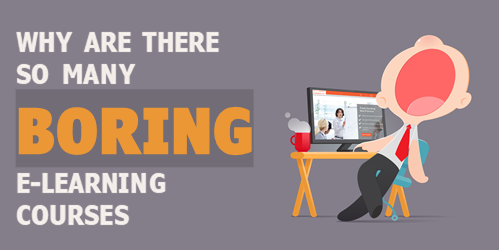Why There Are So Many Bad E-Learning Courses
April 20th, 2021
Like many organizations, we have to take compliance training. And when I heard we had a 3-hour harassment course coming, my first emotional response wasn’t positive. Why do I shudder thinking of taking a 3-hour e-learning course?
We all know why.
I hear all the time that e-learning courses are boring. This isn’t 1995. What’s going on?
We have conferences that teach us how to build better courses. We have an industry full of experts whose whole existence revolves around pointing out boring e-learning and selling their services to de-borify.
I write this blog hoping to combat boring e-learning. We discuss this often in the community and present weekly challenges to instigate thinking about interactive content in different ways. And yet, a lot of e-learning is still boring. Why?
Here are a few observations based on my experience.
Boring E-learning Has Always Existed
Working for a software vendor, I hear all that time that we make boring e-learning possible. The argument is that we’ve equipped too many ignorant people to create “courses.” Apparently, only highly trained instructional designers can build good e-learning. Hog wash! This opinion is both elitist and wrong.
I’ve been in this industry long before the rapid authoring tools were around. E-learning was just as boring then as now. The only difference was that it cost more to make it so there were fewer boring e-learning courses. But trust me, the e-learning courses back then were a lot worse than the ones we have now. And they weren’t created by ignorant people; they were created by instructional designers.
The tools don’t create boring courses, but I will admit that they do make it easier to create a lot of them. But the problem isn’t the authoring tools.
Organizations Get What They Pay For
I’ve been part of hundreds of workshops and talk to people in organization both big and small. And most have a few things in common. The organization buys the software and that’s about it. The developers don’t tend to get much more and must cobble together all sorts of things to build their courses.
But there’s a lot that goes into building great courses.
For many organizations, there’s minimal commitment to ongoing training so that the developers can get more out of the software investment or learn to build better learning experiences. There’s not a lot of commitment to designers who can help craft the right UX designs or graphic designers who can build compelling visuals that support the communication of the content. There’s no multimedia support or access to programmers. Many times, the course developers aren’t even connected to the ones who manage the learning management systems.
Good e-learning requires more than good e-learning software. It requires a commitment to an effective e-learning strategy that helps craft the best learning experiences. I see that many organizations stop at the good software part and let things go from there. And the result is understaffed e-learning developers who operate at the insane speed of business, cranking out content like crazy with little additional support.
That’s a recipe for boring e-learning.
Too Much Focus on Content
When it comes to teaching, we’re very content-centric. Need to know how to change a tire? Go to YouTube. Not sure how to handle this process? Read this PDF. If there’s a need, the gut reaction is to throw more content at it.
Content is fine and obviously part of the learning process. But content isn’t THE learning process. Yet most of the e-learning I see is a lot of content. And it’s often stuff already available in some digital format and then repurposed to look like a course. Add a ten-question quiz and call it good.
Content should be tethered to two things:
- meaningful, relevant context
- performance-based activity
Courses are boring because the content is completely meaningless to the person taking the course (which is the case for a lot of compliance training). Or it’s not framed in a relevant context that helps them understand the content in their real lives.
And then, the course stops at just sharing content with a quiz. There are no supporting activities to practice using it. There’s no opportunity to make real-world decisions and get feedback.
You want your e-learning courses to not be boring? Make an investment in a team that can build good courses, give them the right resources, and focus on learner-centric activities rather than content dumping.
That’s a step in the right direction.
Events
- Everyday. Check out the weekly training webinars to learn more about Rise, Storyline, and instructional design.
Free E-Learning Resources
 |
 |
 |
|
Want to learn more? Check out these articles and free resources in the community. |
Here’s a great job board for e-learning, instructional design, and training jobs |
Participate in the weekly e-learning challenges to sharpen your skills |
 |
 |
 |
|
Get your free PowerPoint templates and free graphics & stock images. |
Lots of cool e-learning examples to check out and find inspiration. |
Getting Started? This e-learning 101 series and the free e-books will help. |





10
comments